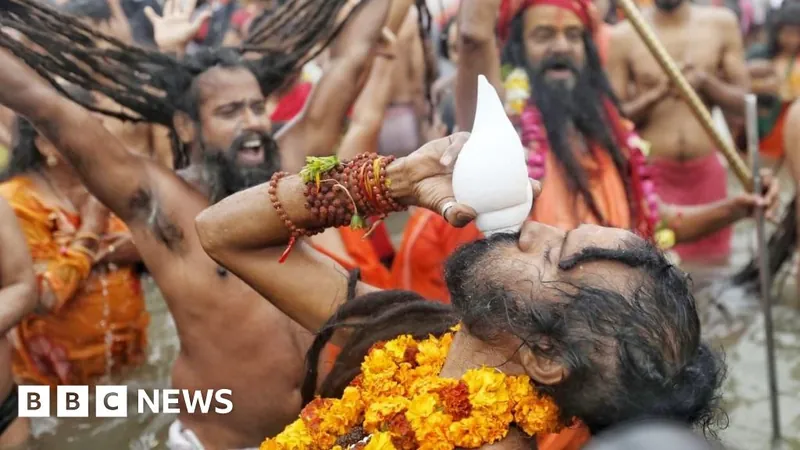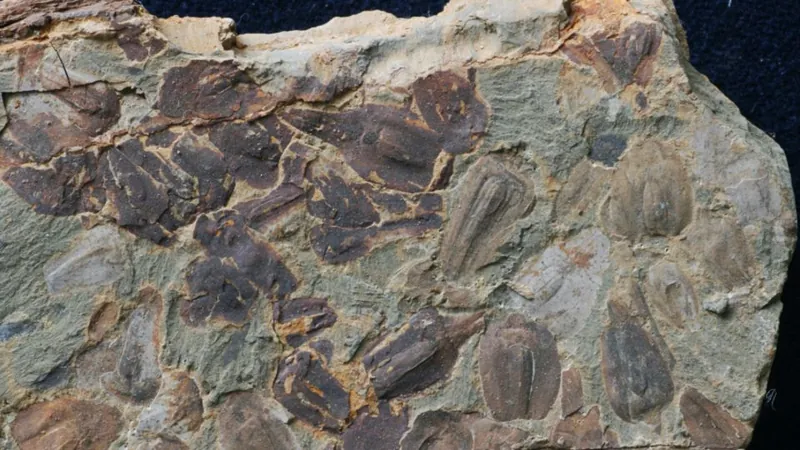
Millions Dive into Sacred Waters at Kumbh Mela: A Spectacle of Faith and Tradition!
2025-01-14
Author: Ken Lee
A Historic Gathering of Devotion
In a breathtaking display of devotion, ash-smeared naked Hindu holy men, known as Naga sadhus, charged into the icy waters of the sacred Ganges River at dawn on the first significant bathing day of the Kumbh Mela festival in Prayagraj, India. This festival, often referred to as Mahakumbh, attracts millions of pilgrims from all corners of the globe, making it one of the largest gatherings of humanity that can even be seen from space.
As they plunged into the waters, the ascetics chanted fervently, invoking the blessings of Hindu gods and goddesses. Emerging from the frigid river, some of the holy men picked up fistfuls of the sacred silver sand, rubbing it over their bodies as a symbol of purification. Adornments included weapons like swords and tridents, with one notable figure holding aloft a silver staff crowned with a snake head.
A Surging Sea of Pilgrims
Tuesday's event marks a critical moment of the Kumbh Mela, which unfolds every 12 years. By midday local time, a staggering 16 million participants had taken their sacred dip, following an impressive turnout of 16.5 million on the previous day. Authorities anticipate that more than 20 million individuals will partake in rituals today alone, contributing to an astounding projected turnout of around 400 million people over the 45-day festival.
Devotees believe that bathing in the Ganges during this auspicious occasion purifies their souls, cleanses them of sins, and aids in attaining salvation by breaking the cycle of life and death. However, managing the massive crowds posed significant challenges. Reports described chaotic scenes as thousands surged into areas designated for the holy men, leading to frustrations voiced by spiritual leaders.
Concerns Over Crowd Control
Mahant Prayag Puri Ji of Juna Akhara expressed concerns over the crowd control measures, lamenting, "We were being shoved and pushed when we went for bathing. It was very crowded, and people were indisciplined. I fell down and hurt my foot." He urged authorities to improve crowd management ahead of the next significant bathing event.
The Royal Bath Rituals
The day's rituals, referred to as Shahi Snan – or the royal bath – featured colorful processions of ascetics arriving at the Sangam, the sacred confluence of the Ganges, Yamuna, and the mythical Saraswati rivers. These processions draw pilgrims from near and far, eager to receive blessings and bask in the holy atmosphere.
A Festival Rooted in Mythology
The origins of Kumbh Mela are steeped in myth, tracing back to a legendary battle between gods and demons over a Kumbh—an ancient pitcher of nectar that surfaced during the churning of the ocean. According to lore, drops of this elixir fell in four cities: Prayagraj, Haridwar, Ujjain, and Nasik, leading to the establishment of Kumbh Mela festivities across these locations, with Prayagraj hosting the grandest celebrations.
A Special Occurrence This Year
This year’s Kumbh Mela is touted as "extra special" due to rare planetary alignments. Mahant Ravindra Puri emphasized the significance of this year's gathering, stating: "We believe that during Kumbh Mela, the waters of the sacred river will be imbued with nectar." He encouraged devotees to have faith, assuring them that "Ganga Maiya [the river goddess] will bless them with whatever they want, whatever they need."
A Testament to Faith and Community
As the whirlwind of rituals continues for the next several weeks, the Kumbh Mela remains an indelible testament to the faith and resilience of millions, showcasing a rich tapestry of traditions that transcend time and space. This spectacular event is not just a religious observance; it represents the strength of collective spirituality and community uniting for a common purpose.


 Brasil (PT)
Brasil (PT)
 Canada (EN)
Canada (EN)
 Chile (ES)
Chile (ES)
 Česko (CS)
Česko (CS)
 대한민국 (KO)
대한민국 (KO)
 España (ES)
España (ES)
 France (FR)
France (FR)
 Hong Kong (EN)
Hong Kong (EN)
 Italia (IT)
Italia (IT)
 日本 (JA)
日本 (JA)
 Magyarország (HU)
Magyarország (HU)
 Norge (NO)
Norge (NO)
 Polska (PL)
Polska (PL)
 Schweiz (DE)
Schweiz (DE)
 Singapore (EN)
Singapore (EN)
 Sverige (SV)
Sverige (SV)
 Suomi (FI)
Suomi (FI)
 Türkiye (TR)
Türkiye (TR)
 الإمارات العربية المتحدة (AR)
الإمارات العربية المتحدة (AR)